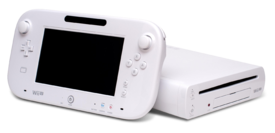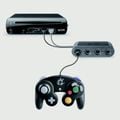Wii U
| Wii U | |
|---|---|
 
| |
| Manufacturer | Nintendo |
| Type | Video game console |
| Generation | Eighth generation era |
| First available | |
| CPU | Tri-core PowerPC750-family "Espresso" |
| GPU | AMD Radeon HD series "Latte" |
| Media | 12 cm Wii U Optical Disc, 12 cm Wii Optical Disc |
| System storage | Internal flash memory, SD card, SDHC Card, USB mass storage device |
| Controller input | Wii U GamePad, Wii U Pro Controller, Wii Remote, Nunchuk, Classic Controller, Nintendo Gamecube controller (via an adapter) |
| Connectivity | Wi-Fi Bluetooth USB 2.0 x4 LAN Adapter (via USB) |
| Backward compatibility | Wii |
| Predecessor | Wii |
| Successor | Nintendo Switch |
| Article on Nintendo Wiki | Wii U |
The Wii U is the sixth internationally released home video game console released by Nintendo. The console is the direct successor to the Wii and competed with Sony's PlayStation 4 and Microsoft's Xbox One console in the eighth generation of video game consoles.
The console is capable of 1080p graphics, but its main distinguishing feature is its controller: the Wii U GamePad. It features a 6-inch touchscreen capable of streaming gameplay seen on the TV screen, serving an original purpose to the intended game, or playing the whole game altogether. The controller also features a camera. The Wii U is backwards-compatible with the Wii, supporting up to four Wii Remotes and all such accessories. A more traditional controller called the Wii U Pro Controller is also available. The Wii U is not compatible with GameCube games by official means. However, an official adapter was made to connect Nintendo GameCube controllers to a Wii U. The Nintendo GameCube adapter works exclusively with Super Smash Bros. for Wii U.
Nintendo first spoke of the console at the 2011 E3 press conference, before revealing new details at a Nintendo Direct conference one day before E3 2012. It was released later that year at varying times depending on the region.
Unlike the original Wii and much like the Nintendo GameCube, the Wii U was not very successful when compared to its contemporaries. It was initially expected to sell 100 million units[1], but the system only managed to sell 13.56 million units worldwide, making it both a commercial failure and Nintendo's least successful home console to date after the GameCube. Because of this, the Wii U was discontinued in Europe on October 1, 2016, in North America on November 10, 2016, in Australia on November 14, 2016, and in Japan on January 31st, 2017.[2] The Nintendo Switch outsold the Wii U's lifetime sales in only nine months since its release. Numerous Wii U games however have been ported over to the Switch in lieu of backwards compatibility.
In the Super Smash Bros. series
Super Smash Bros. for Wii U was released for the Wii U on November 21st, 2014 in North America, in Europe on November 28, 2014, in Australia and New Zealand on November 29, 2014, and in Japan on December 6, 2014. As the Wii U is backwards-compatible with Wii games and the Wii Virtual Console, the console can also run Super Smash Bros. Brawl and Super Smash Bros. (on Virtual Console for Wii).
Two playable characters in the Super Smash Bros. series hail from games originally released for Wii U:
Gallery
References
External links
| Nintendo consoles | |
|---|---|
| Home consoles | Color TV-Game 15 · Nintendo Entertainment System · Super Nintendo Entertainment System · Virtual Boy · Nintendo 64 · Nintendo GameCube · Wii · Wii U |
| Handheld consoles | Game & Watch · Game Boy · Game Boy Color · Game Boy Advance · Nintendo DS · Nintendo 3DS |
| Hybrid consoles | Nintendo Switch |




